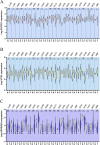CD39/CD73/A2AR pathway and cancer immunotherapy
- PMID: 36859386
- PMCID: PMC9979453
- DOI: 10.1186/s12943-023-01733-x
CD39/CD73/A2AR pathway and cancer immunotherapy
Abstract
Cancer development is closely associated with immunosuppressive tumor microenvironment (TME) that attenuates antitumor immune responses and promotes tumor cell immunologic escape. The sequential conversion of extracellular ATP into adenosine by two important cell-surface ectonucleosidases CD39 and CD73 play critical roles in reshaping an immunosuppressive TME. The accumulated extracellular adenosine mediates its regulatory functions by binding to one of four adenosine receptors (A1R, A2AR, A2BR and A3R). The A2AR elicits its profound immunosuppressive function via regulating cAMP signaling. The increasing evidence suggests that CD39, CD73 and A2AR could be used as novel therapeutic targets for manipulating the antitumor immunity. In recent years, monoclonal antibodies or small molecule inhibitors targeting the CD39/CD73/A2AR pathway have been investigated in clinical trials as single agents or in combination with anti-PD-1/PD-L1 therapies. In this review, we provide an updated summary about the pathophysiological function of the adenosinergic pathway in cancer development, metastasis and drug resistance. The targeting of one or more components of the adenosinergic pathway for cancer therapy and circumvention of immunotherapy resistance are also discussed. Emerging biomarkers that may be used to guide the selection of CD39/CD73/A2AR-targeting treatment strategies for individual cancer patients is also deliberated.
Keywords: A2AR; Adenosine receptor; CD39; CD73; Cancer immunotherapy; Immunosuppressive tumor microenvironment.
© 2023. The Author(s).
Conflict of interest statement
The authors declare no competing interests.
Figures


References
-
- Baghbani E, Noorolyai S, Shanehbandi D, Mokhtarzadeh A, Aghebati-Maleki L, Shahgoli VK, et al. Regulation of immune responses through CD39 and CD73 in cancer: novel checkpoints. Life Sci. 2021;(282):119826. - PubMed
Publication types
MeSH terms
Substances
LinkOut - more resources
Full Text Sources
Medical
Research Materials

